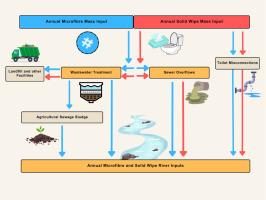当前位置:
X-MOL 学术
›
Water Res.
›
论文详情
Our official English website, www.x-mol.net, welcomes your
feedback! (Note: you will need to create a separate account there.)
Predicting flushed wet wipe emissions into rivers
Water Research ( IF 11.4 ) Pub Date : 2024-11-01 , DOI: 10.1016/j.watres.2024.122733 Thomas Allison, Benjamin D. Ward, Isabelle Durance, Michael Harbottle
Water Research ( IF 11.4 ) Pub Date : 2024-11-01 , DOI: 10.1016/j.watres.2024.122733 Thomas Allison, Benjamin D. Ward, Isabelle Durance, Michael Harbottle

|
Flushed wet wipes pose a significant pollution risk to river systems at both macro and micro levels. However, the link between their emissions and environmental contamination remains unclear. Here we integrated emissions-based modelling with existing data on wet wipe disposal and microfibre generation to predict the quantity of emissions entering river systems and the transport pathways involved. Results indicate that wastewater pathways, including sewer overflows, wastewater treatment plants, and agricultural runoff, are major conduits for these pollutants. Despite advanced wastewater treatment, substantial microfibre emissions still enter the environment. Extrapolating to larger scales reveals wet wipe pollution as an international issue requiring urgent attention. This research offers a comprehensive modelling framework applicable to various wastewater pollutants, providing valuable insights for policymakers and the water industry. Improved data on wet wipe disposal, fate, and spatially distributed wastewater systems are necessary to pinpoint their environmental risks more accurately.
中文翻译:

预测冲刷湿巾排放到河流中
冲洗的湿巾在宏观和微观层面上都对河流系统构成重大污染风险。然而,它们的排放与环境污染之间的联系仍不清楚。在这里,我们将基于排放的模型与湿巾处理和微纤维生成的现有数据相结合,以预测进入河流系统的排放量和所涉及的运输路径。结果表明,包括下水道溢流、废水处理厂和农业径流在内的废水途径是这些污染物的主要渠道。尽管废水处理技术先进,但仍有大量超细纤维排放物进入环境。从更大的尺度推断表明,湿巾污染是一个需要紧急关注的国际问题。这项研究提供了一个适用于各种废水污染物的综合建模框架,为政策制定者和水务行业提供了有价值的见解。改进湿巾处理、归宿和空间分布废水系统的数据对于更准确地确定其环境风险是必要的。
更新日期:2024-11-06
中文翻译:

预测冲刷湿巾排放到河流中
冲洗的湿巾在宏观和微观层面上都对河流系统构成重大污染风险。然而,它们的排放与环境污染之间的联系仍不清楚。在这里,我们将基于排放的模型与湿巾处理和微纤维生成的现有数据相结合,以预测进入河流系统的排放量和所涉及的运输路径。结果表明,包括下水道溢流、废水处理厂和农业径流在内的废水途径是这些污染物的主要渠道。尽管废水处理技术先进,但仍有大量超细纤维排放物进入环境。从更大的尺度推断表明,湿巾污染是一个需要紧急关注的国际问题。这项研究提供了一个适用于各种废水污染物的综合建模框架,为政策制定者和水务行业提供了有价值的见解。改进湿巾处理、归宿和空间分布废水系统的数据对于更准确地确定其环境风险是必要的。


















































 京公网安备 11010802027423号
京公网安备 11010802027423号